Opera House
Introduction
Text-to-speech Audio
The Alliance Opera House (also known as the Crew opera House and the Marchand Opera House) stood on this site from 1868 until 1886. It is best remembered for its ignominious collapse, but was also the most important gathering place in Alliance during its two decades of operation. It was the venue for famous performers and touring companies of the post-Civil War era, hosted community and political events, and was the site of desperate meetings to keep the peace in Alliance during America’s Great Railroad Strike of 1877. It also housed prominent businesses, including that of its illustrious builder at the center of early Alliance’s bustling business district.
Images
Drawing of the Opera House when it opened
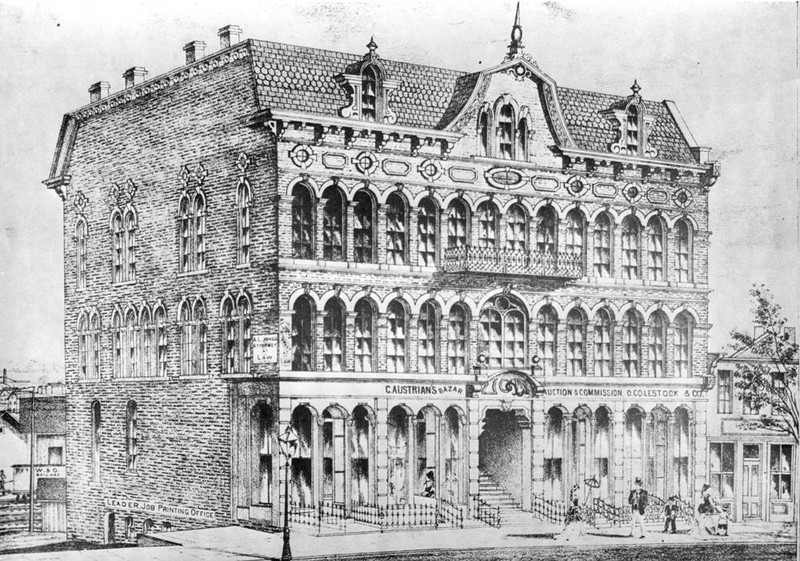
Opera House just after its collapse on June 2, 1886
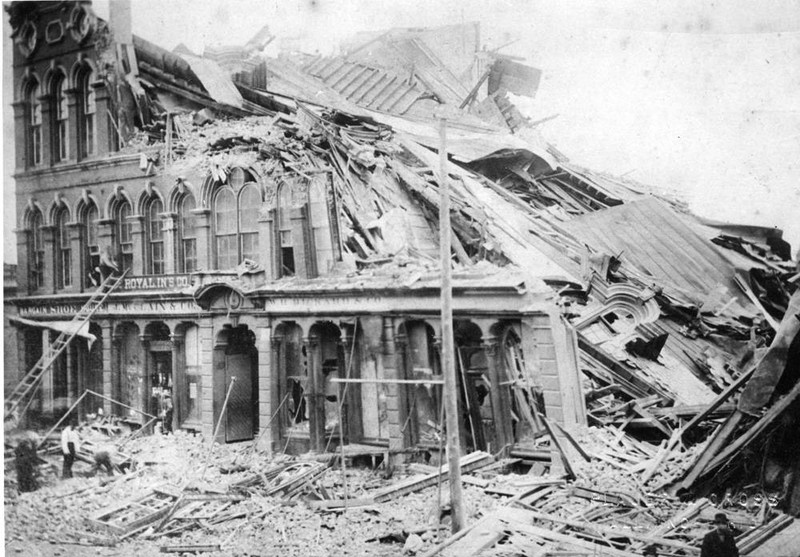
Northeast corner of E. Main Street & Seneca where the Opera House once stood
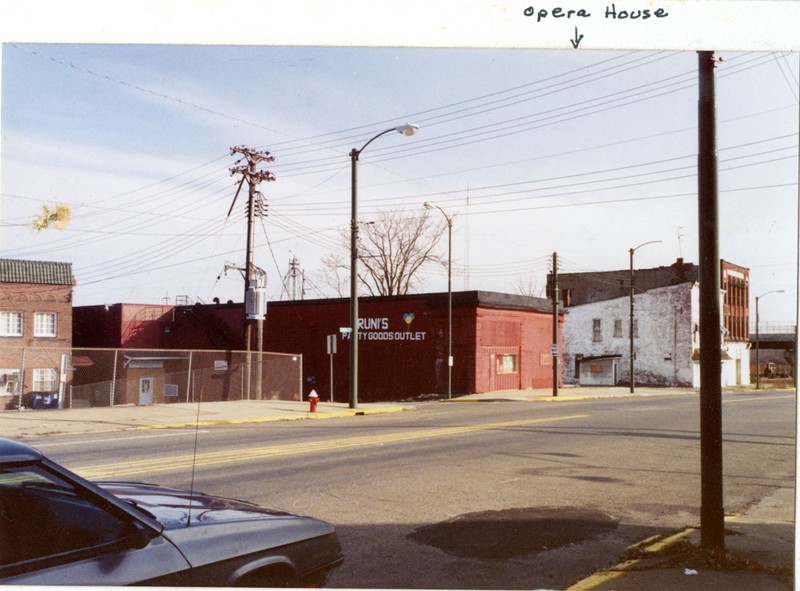
Chuck's Inn
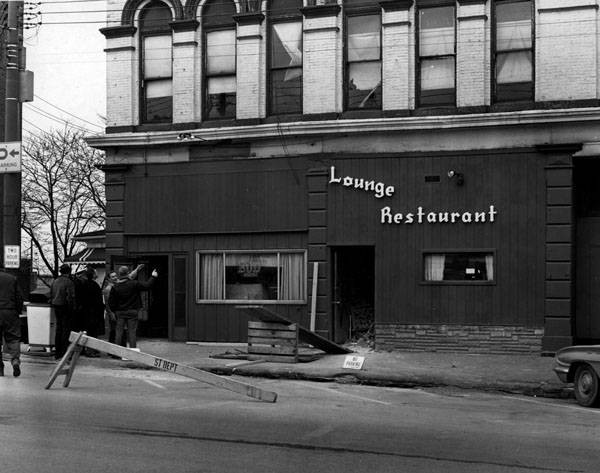
Chuck's Inn after collapse
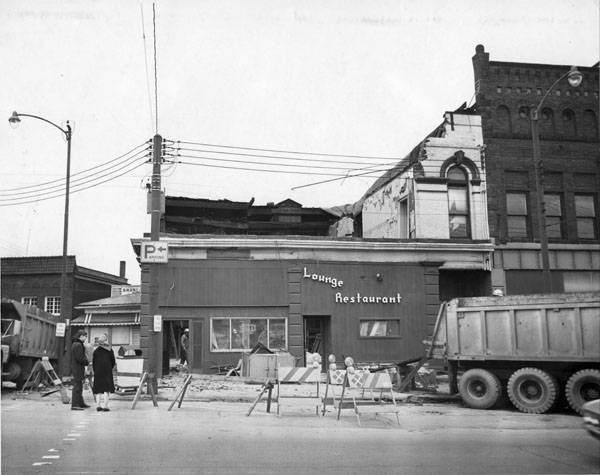
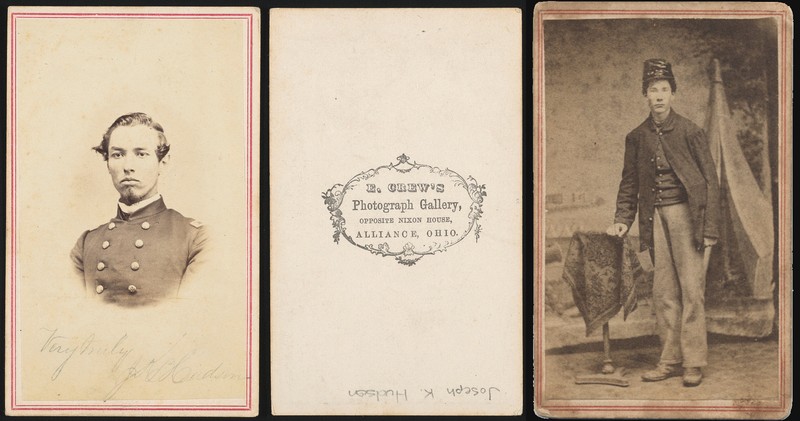
Backstory and Context
Text-to-speech Audio
Architect and preservation writer Bruce Snyder noted that “In the rapidly expanding United States of the late 19th century, anywhere that wished to be considered somewhere needed an opera house.” They were a mainstay of main streets across America, but they only infrequently presented operas—they were the one-night stand for touring musicians, speakers, and theater companies (high drama to low comedy), and just as importantly, according to author Ann Satterthwaite, they “were often in places where it was the only sort of neutral turf for a community hall.” They could also be very profitable, a significant consideration for businessmen of the 19th, and every other century since.
Such was the goal of young Emmor Crew of Damascus, one of the entrepreneurial spirits who came to Alliance in the 1850s with the arrival of the railroads, and made his way as a photographer. By 1860 he was a leader of local Lincoln supports and served as the chairman of the Alliance Committee who welcomed the President-elect at the Alliance train station on his inaugural trip to Washington DC February 15, 1861. Crew introduced the tall, newly-bearded man from Illinois to the thousands waiting at a makeshift platform at The Crossing. He would spend much of the ensuing years creating portraits of soldiers passing through Alliance on trains during the Civil War at his studio near that same station.
After the War, Crew took a bold step by building the first Alliance Opera House, a three-story structure at the northeast corner of Alliance Street (now Main) and Fifth Street (now Seneca Ave), an imposing site encompassing most of the western have of the block. The first floor held retail store rooms while the second floor featured. Crew’s Photography Studio and other offices, and the 1,000-seat opera hall was located on the third floor. The cost of the building was estimated at $75,000.
Though Crew enjoyed only modest success with the Opera House, as his focus was on his photography business, and he eventually decided to move to Texas, reportedly for his health, where he operated a watermelon farm. Local investor and merchant Charles Marchand purchased the building in 1877 for $17,000, and with his son as manager revitalized the opera houses main business.
Although Marchand had invested $15-20,000 in renovations after his purchase, seven years later there were doubts to its safety and arrangements were in progress to put it in a secure condition when it was inspected by J. T. Weybrecht the morning of June 2, 1886. He warned all inhabitants to vacate the premises. At approximately 4:30 p.m., the building collapsed. The cause was thought to be partially defective bricks used for its original construction. There was some speculation that vibrations from closely passing railroad trains contributed to the shifting of the bricks. No one was hurt in the collapse.
F. C. Marchand used much of the western half of the building to rebuild a two-story business block. Remnants of the building were still extant until the final demolition in 1971 after Chuck’s Inn collapsed during renovation.
Items of Note
• Prior to being located on the Public Square, city offices were located in the Crew building and council met there when passing the ordinance to build a free-standing Town Hall.
• Occupants in the building included the E. McConnel shoe store, J. Hiller’s notions shop, L. H. Nogel’s tin shop and stove store, the offices of Dr. Cleverly, Attorney (and former mayor) Harvey Laughlin, and Johnson & Son, in addition to the Marchand office and opera hall.
• According to the Review, among the highlights of the Winter & Spring 1886 season were Prof. George Widle champion gymnast and leaper of the world, leaping 40 feet on the Hying trapeze; Daniel Solly's Grocery as played 150 nights in New York; A Russian Honeymoon, produced by the Madison Square Theater more than 100 times; A Hot Time, the greatest musical comedy of the day; the eminent actor Edwin Thorne in the London and New York sensation The Black Flag: the charming little actress Bella Moore; Robert McWade in Rip Van Winkle; Mattie Vickers; J. Z. Little's World, including the following scenes: The Departure, The Sinking Ship, The Raft, The Lunatic Asylum, and The Revolving Wall.
• Belle Rosenberg, long time Alliance resident who witnessed the top of the Orr Block explosion, was not near the collapse at the Opera House when it happened two years later but was among the thousands that went to the scene to view its aftermath, grateful that no one was killed.
• Two community meetings held at the Opera House with striking railroad employees on July 22 and 26, 1877 helped Alliance, which was at a new high point as a Pennsylvania Railroad town, find a middle ground in supporting the strikers’ goals while protecting goods and property on the station grounds. Meanwhile, the pinnacle of The Great Railroad Strike’s destruction where the Pittsburgh depot and rail yards were burnt to the ground and forty died.
Sources
"Alliance Opera House Handbill," Alliance Memory. Accessed May 23, 2024. https://www.alliancememory.org/digital/collection/places/id/740/rec/3.
"Sunshine to Greenback: An incomplete history of Ohio photographer Emmor Crew," Timothy Brookes. https://mahoningvalleycwrt.com/wp-content/uploads/2018/12/sunshine-to-greenbacks.pdf
E. T. Heald, The Stark County Story - Towns and Villages – Vol I, 1949, pp. 540-546
Alliance Review, Review Publishing Co, Alliance Ohio – 1913-03-22, 1914-03-14, 1919-12-30
"Reminiscences of Belle Rosenberg," Alliance Memory Accessed May 23, 2024. https://www.alliancememory.org/digital/collection/voices/id/147/rec/5
https://www.alliancememory.org/digital/collection/places/id/674/rec/7
https://www.alliancememory.org/digital/collection/places/id/662/rec/5
Alliance Historical Society collection
https://www.alliancememory.org/digital/collection/places/id/904/rec/11
https://www.alliancememory.org/digital/collection/places/id/902/rec/9
